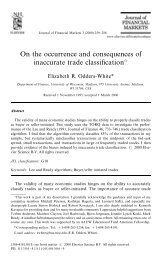A generic framework for Arabic to English machine ... - Acsu Buffalo
A generic framework for Arabic to English machine ... - Acsu Buffalo
A generic framework for Arabic to English machine ... - Acsu Buffalo
You also want an ePaper? Increase the reach of your titles
YUMPU automatically turns print PDFs into web optimized ePapers that Google loves.
/><br />
<strong>English</strong>Translate=“read”<br />
Table 5.2: Verb 2<br />
<strong>Arabic</strong> verb <br />
ktbt<br />
<strong>English</strong> translation wrote<br />
Logical structure [do’(x,[write’(x,(y)])]<br />
Tense past<br />
Gender f<br />
Person 3rd<br />
Number singular<br />
LogicalStructures= “”<br />
NumberVerb=“sg”<br />
P.O.S=“Verb”<br />
genderVerb=“M”<br />
personVerb=“3rd”<br />
tenseVerb=“PAST”<br />
5.3 Design of test strategy<br />
5.3. DESIGN OF TEST STRATEGY<br />
We will create variants of <strong>Arabic</strong> sentences that represent all possible structures of sen-<br />
tences that UniArab can translate. We will evaluate the result of the system output by<br />
comparing between human-translated and <strong>machine</strong>-translated versions. In Tables 5.3 <strong>to</strong><br />
5.9 we represent some examples of sentences that are used <strong>to</strong> test the UniArab system.<br />
For actual test examples see Appendix C.<br />
Verb-Subject one argument in deferent tenses:<br />
In Table 5.3, Verb-Subject Agreement with two arguments sentences, are sentences where<br />
UniArab should select the correct <strong>for</strong>m of the verb. In particular the verb must agree with<br />
the subject.<br />
74
















